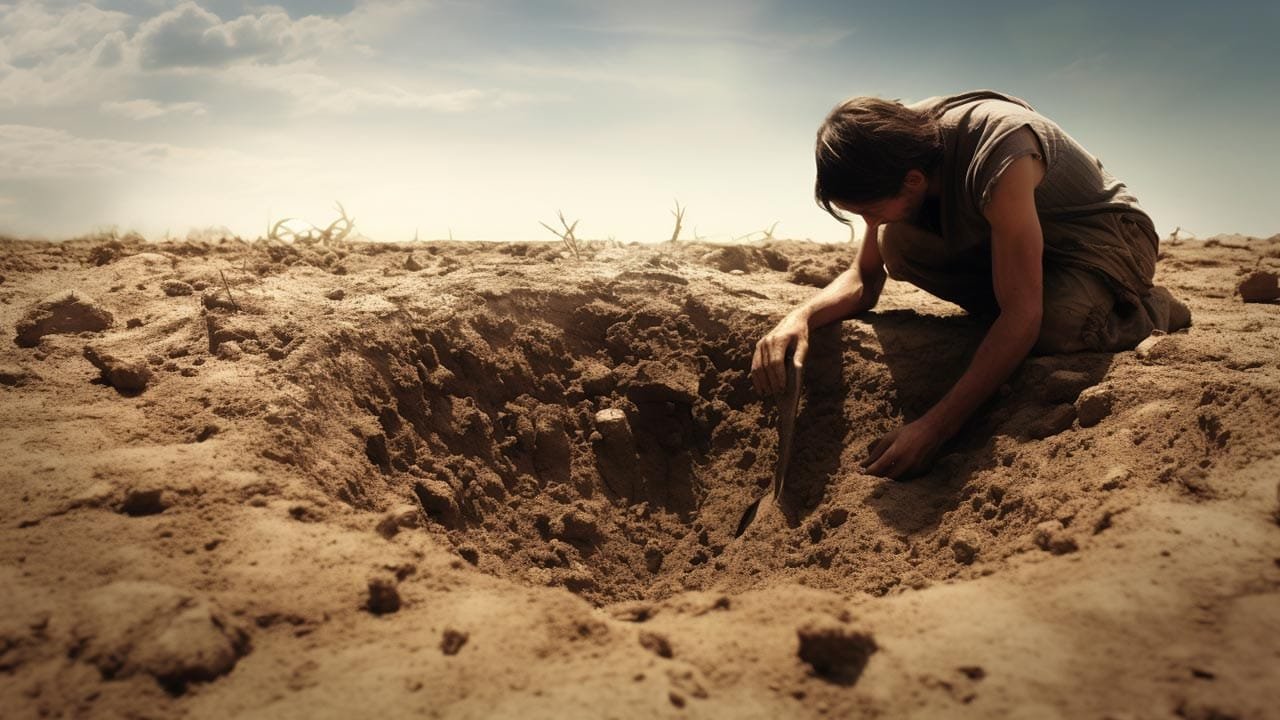Water is the essence of life. It’s a fundamental requirement for the survival of all known forms of life, and its scarcity can lead to dire consequences. Whether you’re an adventurer lost in the wilderness, a survivalist preparing for the worst, or simply curious about the art of finding water, this article is for you. In the next sections, we will delve deep into the best tricks for finding water, drawing from age-old wisdom, modern science, and expert opinions. By the end of this article, you’ll be equipped with the knowledge to source water in the most challenging environments, ensuring your survival and well-being.
Best Tricks for Finding Water
Table of Contents
- Understanding the Importance of Water
- Natural Indicators of Water
- Collecting Dew and Rainwater
- Solar Stills: Harnessing the Sun
- Digging for Water
- Frequently Asked Questions
- Final Thoughts
- Sources
Understanding the Importance of Water
Water, often termed the “elixir of life,” plays a pivotal role in the sustenance of life on Earth. Its significance is not just limited to quenching thirst but extends to a myriad of physiological, ecological, and even cultural aspects of our existence. This section will delve into the multifaceted importance of water, shedding light on its role in human health, the environment, and its cultural and spiritual significance.
Physiological Importance
Water is the cornerstone of human health. It aids in:
- Digestion and Nutrient Absorption: Water breaks down food, allowing the body to absorb nutrients.
- Detoxification: It helps in flushing out toxins and waste products through urine and sweat.
- Temperature Regulation: Through processes like sweating, water helps maintain the body’s internal temperature.
- Joint Lubrication: Water acts as a lubricant for joints, reducing friction and wear.
Ecological Significance
Water is the lifeblood of our planet. It:
- Supports Biodiversity: Freshwater habitats house a plethora of species, many of which are specially adapted to aquatic life.
- Drives the Water Cycle: Evaporation, condensation, and precipitation – all crucial processes of the water cycle – ensure that water is distributed across the planet.
- Shapes Landscapes: Rivers and glaciers have carved out valleys, gorges, and other landforms over millennia.
Cultural and Spiritual Relevance
Water has deep-rooted cultural and spiritual significance:
- Ritualistic Uses: Many religions use water for purification rites, baptisms, and other ceremonies.
- Symbolism: Water often symbolizes life, purity, and renewal in various cultures and mythologies.
Economic Value
Water drives economies:
- Agriculture: Irrigation is essential for crop cultivation in many parts of the world.
- Industry: From cooling machinery to being a key ingredient in products, water is indispensable in industries.
- Recreation: Water bodies are hubs for recreational activities like boating, fishing, and tourism.
Understanding the importance of water is paramount. It’s not just a simple molecule but a force that drives life, cultures, and economies.
Natural Indicators of Water
Nature, with its intricate web of ecosystems and life forms, often provides subtle yet reliable cues about the presence of water. These indicators can be especially valuable for those navigating unfamiliar terrains or facing survival situations. This section will explore various natural signs that can guide one to water sources, from observing vegetation and wildlife to understanding geographical features.
Vegetation as a Clue
Certain plants thrive in areas with abundant water:
- Willows and Cottonwoods: These trees often grow near water sources.
- Reeds and Cattails: Typically found in marshy areas or along the edges of ponds and lakes.
- Green Patches: In arid regions, a patch of green vegetation can indicate an underground water source.
Animal Behavior and Tracks
Animals, especially in dry regions, are adept at finding water:
- Bird Flight Patterns: Birds like pigeons and doves often fly straight to water sources during dawn and dusk.
- Mammal Tracks: Concentrated animal tracks can lead to a water hole. Animals like deer and antelope require water daily.
- Grazing Paths: Herbivores often graze in patterns that lead them to water sources.
Insect Activity
Certain insects are reliable indicators of water:
- Mosquitoes: They breed in stagnant water, so their presence can indicate a water source nearby.
- Dragonflies: Often found hovering around water bodies, especially during their breeding season.
- Ants: Some species are known to store water, and a trail of ants ascending a tree can indicate stored water in tree hollows.
Geographical Features
The lay of the land can hint at water:
- Valleys and Low Points: Water naturally flows downwards, so valleys and depressions are likely spots.
- Dry Riverbeds: Even if they’re dry on the surface, digging a few feet can reveal trapped water.
- Mountain Bases: The base of mountains or hills can have streams resulting from melting snow or underground springs.
Atmospheric Indications
The sky and atmosphere can also provide clues:
- Morning Mist: Indicates that water evaporated during the night and condensed in the cooler morning air.
- Cloud Formations: Clouds moving towards a particular direction can lead to a water body.
Nature is replete with signs pointing towards water. Being observant and understanding these indicators can be the key to finding this precious resource in the most challenging terrains.
Collecting Dew and Rainwater
Dew and rainwater are among the purest forms of water available in nature. While rainwater is a direct gift from the skies, dew is the result of atmospheric moisture condensing on cooler surfaces during the night. Both sources can be invaluable in situations where conventional water sources are scarce or contaminated. This section will guide you through the methods and precautions to effectively collect and utilize dew and rainwater.
The Science Behind Dew Formation
Dew forms when the air becomes saturated with moisture, and the temperature drops to the dew point or below. This causes the moisture in the air to condense on cooler surfaces, such as leaves, grass, and metal surfaces.
Methods to Collect Dew
Collecting dew requires simple techniques:
- Cloth Method: Dragging a clean cloth or towel over grass or vegetation early in the morning. The cloth will absorb the dew, which can then be wrung out into a container.
- Plastic Sheet Method: Laying a plastic sheet on the ground overnight. The dew will condense on the sheet, which can be tilted to direct the water into a container.
- Leaf Funneling: Large leaves can act as natural funnels. Positioning a container beneath such leaves can help collect the dew that drips off.
Understanding Rainwater
Rainwater is precipitation that falls directly from the sky. It’s relatively pure, though it can pick up contaminants as it falls through the atmosphere.
Rainwater Harvesting Techniques
Efficiently collecting rainwater can provide a substantial water supply:
- Roof Catchment Systems: Using gutters and downspouts attached to roofs, directing rainwater into storage tanks.
- Rain Barrels: Placing barrels or other large containers under roof downspouts.
- Tarps and Plastic Sheets: Creating a funnel with tarps or plastic sheets to guide rainwater into containers.
- Natural Landform Collection: In hilly terrains, rainwater naturally flows down and can be collected in dugout ponds or reservoirs.
Safety and Purification
While dew and rainwater are generally pure, they can contain contaminants:
- Boiling: Boiling water for at least 10 minutes can kill most pathogens.
- Filtration: Using commercial water filters or homemade ones with sand and charcoal layers.
- Chemical Treatment: Using water purification tablets or drops.
Dew and rainwater are invaluable natural resources, especially in survival situations. With the right techniques and safety precautions, they can provide a reliable source of clean water.
Solar Stills: Harnessing the Sun
Solar stills are ingenious devices that utilize the sun’s energy to extract and purify water from various sources, including contaminated water, soil, and even plant material. They operate on the principles of evaporation and condensation, mimicking the natural water cycle on a smaller scale. This section delves into the mechanics of solar stills, their construction, benefits, and potential limitations.
Principle Behind Solar Stills
Solar stills work on a simple principle:
- Evaporation: The sun’s heat causes water within the still to evaporate, leaving contaminants behind.
- Condensation: As the vapor rises, it condenses on the cooler surface of the still’s cover.
- Collection: The condensed water droplets then trickle down and are collected in a container.
Constructing a Basic Solar Still
Here’s a step-by-step guide to creating a rudimentary solar still:
- Dig a Hole: In a sunny location, dig a hole about 2 feet deep and 3 feet wide.
- Place a Container: Position a clean container in the center of the hole.
- Add Contaminated Water/Plant Material: If you’re purifying dirty water, pour it around the container but not inside. Alternatively, you can place moisture-rich plant material around the container.
- Cover with Plastic: Stretch a clear plastic sheet over the hole, sealing its edges with soil or rocks.
- Place a Weight: Put a small rock or weight in the center of the plastic, just above the container. This creates a downward slope for the condensed water to drip into the container.
- Wait and Collect: As the sun heats the ground, water will evaporate, condense on the plastic, and drip into the container.
Advanced Solar Still Designs
While the basic design is effective, there are advanced models that can increase efficiency:
- Wick Solar Stills: Incorporate cloth wicks to draw water from a larger area, increasing evaporation rates.
- Inclined Solar Stills: Designed with a tilted condensation surface, promoting faster water collection.
- Multi-basin Stills: Multiple basins allow for the simultaneous distillation of larger water volumes.
Benefits of Solar Stills
Solar stills offer several advantages:
- Purification: They effectively remove contaminants, including salts, bacteria, and heavy metals.
- Versatility: They can extract water from various sources, including soil and plants.
- Sustainability: They rely solely on solar energy, making them environmentally friendly.
Limitations and Considerations
While beneficial, solar stills have some constraints:
- Output: A basic solar still might only produce a limited amount of water daily.
- Weather Dependency: Their efficiency is significantly reduced on cloudy or short days.
- Maintenance: The plastic sheeting can degrade over time and might need replacement.
Solar stills are a testament to human ingenuity, turning a basic scientific principle into a life-saving tool. Whether you’re a survivalist or someone interested in sustainable water purification methods, understanding and harnessing the power of solar stills can be immensely beneficial.
Digging for Water

In many parts of the world, especially arid regions, surface water sources like rivers and lakes may be scarce or non-existent. However, beneath the ground, hidden reservoirs of water, known as groundwater, can often be accessed by digging. This section will explore the art and science of finding water by digging, offering insights into where to dig, how to dig, and the precautions to consider.
Understanding Groundwater
Groundwater is water that fills the gaps and voids in underground soil and rock layers. It originates from rain and melting snow that seeps into the ground. The top surface of groundwater is called the water table, which can be close to the ground surface or many meters below, depending on the region.
Best Places to Dig
Identifying the right spot increases the chances of finding water:
- Dry Riverbeds: Even if they appear dry, these beds can have water just a few feet below the surface.
- Vegetation Patches: In arid areas, green vegetation often indicates underground moisture.
- Depressions and Valleys: Low points in the landscape are more likely to intersect the water table.
- Animal Behavior: Observing where animals like birds or large mammals gather in the early morning or late evening can hint at water sources.
Digging Techniques
Once a potential spot is identified, the digging process begins:
- Hand Digging: Using tools like shovels or even hands to dig a hole. It’s labor-intensive but often effective in sandy or soft soil.
- Augering: Using a hand auger, which is a spiral tool turned to drill into the ground. Suitable for harder soils.
- Depth: Typically, you might need to dig 5-15 feet, but this varies based on the location and the depth of the water table.
Safety Considerations
Digging, especially in unfamiliar terrains, comes with risks:
- Soil Instability: There’s a risk of the hole collapsing, especially in sandy or loose soils.
- Contaminants: In areas near human habitation, groundwater might be contaminated with chemicals or waste.
- Exhaustion: Digging is physically demanding. It’s essential to stay hydrated and take breaks.
Purifying the Extracted Water
Water sourced by digging, especially near the surface, may contain impurities:
- Boiling: A reliable method to kill pathogens.
- Filtration: Using cloth or commercial filters to remove particulates.
- Solar Disinfection: Placing water in clear plastic bottles and exposing them to sunlight for several hours can kill many pathogens.
Digging for water is an age-old technique that has sustained civilizations and saved countless lives in survival situations. With the right knowledge and precautions, it remains a vital skill for accessing the life-giving resource hidden beneath our feet.
Frequently Asked Questions
Final Thoughts
Finding water is an essential skill that can mean the difference between life and death in survival situations. The most crucial takeaway from this article is the importance of being observant and using both traditional and modern methods to source water. Always prioritize safety and ensure that any water sourced is purified before consumption.






Leave A Comment